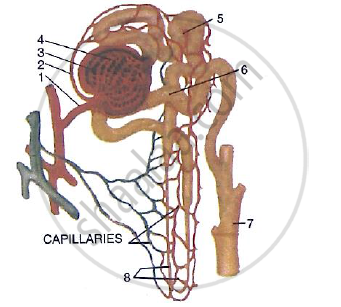Advertisements
Advertisements
प्रश्न
Answer the following question:
Explain the human excretory system with the help of a suitable diagram.
उत्तर
Describe the excretory system in human beings.
- Human excretory system

- The excretory system in human beings includes a pair of kidneys, a pair of ureters, urinary bladder and urethra. Kidneys remove the waste products from the blood and form urine.
- Kidneys are two bean-shaped structures located at the back of the abdomen, one on either side of the vertebral column. The right kidney is placed slightly lower than the left kidney.
- Though the kidneys are the major excretory organs in a human being, the skin and the lungs also help in the process of excretion.
- An average person has around 5 litres of blood which the kidneys filter about 400 times a day. Kidneys filter out about 190 litres of filtrate daily to produce 1-1.9 litres of urine, rest is reabsorbed.
APPEARS IN
संबंधित प्रश्न
Give biological reasons for the following statements: There is frequent urination in winter than in summer
Write the functions of Kidney
Fill in the following blank with suitable word:
Bowman's capsule and tubule taken together make a..........
What is the name of the tubes which connect the kidneys to bladder?
Tick the most appropriate answer.
The process of removing waste from the body is called
Tick the most appropriate answer.
Quinine is used in the treatment of
Fill in the blank.
....................... are present in the stem of pine tree that make the pinewood strong and durable.
Answer the following in detail.
Explain the process of transpiration. Describe some factors that affect it.
Why is it necessary to maintain a normal osmotic concentration of the blood?
Define the following term :
Renal pelvis
Define the following term:
Osmoregulation
The following diagram represents a mammalian kidney tubule (nephron) and its blood supply.

Parts indicated by the guidelines 1 to 8 are as follows:
1. Afferent arteriole from renal artery
2. efferent arteriole
3. Bowman’s capsule
4. Glomerulus;
5. Proximal convoluted tubule with blood capillaries;
6. Distal convoluted tubule with blood capillaries;
7. collecting tubule;
8. U-shaped loop of Henle
Study the diagram and answer the question that follow:
Where does ultrafiltration take place?
Choose the odd one out in the following series:
Renal fat, renal capsule, nerve.
Give Technical Term:
The duct which transports urine from the kidney to the urinary bladder.
Complete the following sentence with appropriate word:
______ supplies blood to kidney.
Choose the correct option.
Deproteinised plasma is not found in ______.
The process of diffusion of solvent particles from the region of less solute concentration to a region of high solute concentration through a semi-permeable membrane is known as ____________.
Why is the rate of breathing in aquatic organisms much faster than in terrestrial organisms?
Give two examples of the following:
Main excretory organs
